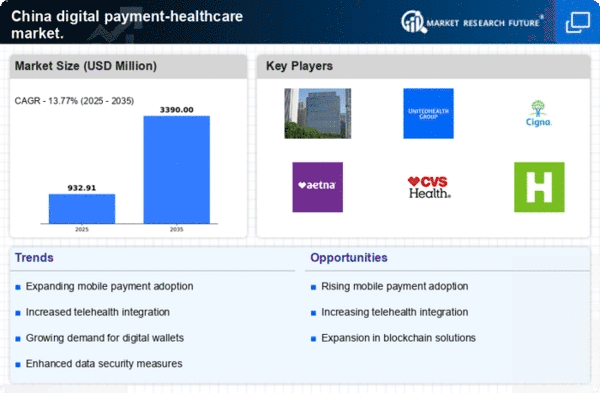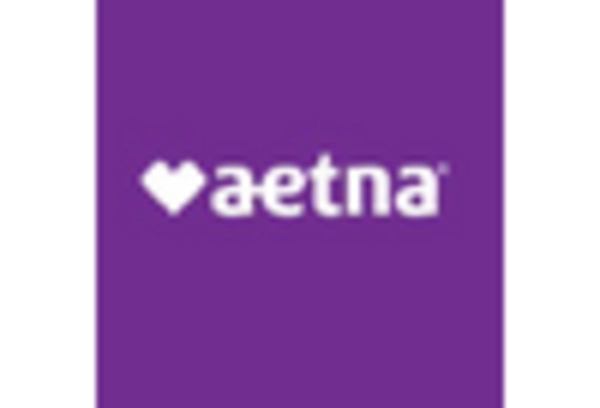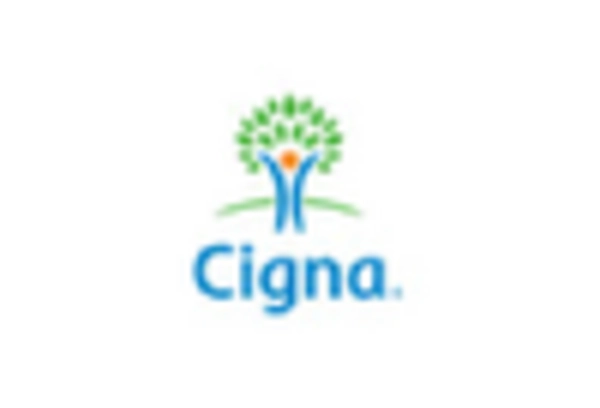Expansion of Telehealth Services
The expansion of telehealth services significantly influences the digital payment-healthcare market in China. As telehealth becomes more prevalent, the need for efficient digital payment solutions grows correspondingly. Patients utilizing telehealth services require seamless payment methods to facilitate consultations and treatments. By 2025, it is projected that telehealth services will account for over 30% of healthcare interactions, necessitating robust digital payment systems. This shift not only enhances patient access to healthcare but also drives the adoption of digital payment solutions among providers. The digital payment-healthcare market is thus poised for growth as telehealth continues to reshape the healthcare landscape.
Rising Demand for Contactless Transactions
The digital payment-healthcare market in China experiences a notable surge in demand for contactless transactions. This trend is driven by the increasing preference for convenience and safety among consumers. As of 2025, approximately 70% of healthcare transactions are expected to be conducted through contactless methods, reflecting a significant shift in consumer behavior. The integration of mobile wallets and QR code payments facilitates seamless transactions, enhancing patient experiences. Furthermore, healthcare providers are increasingly adopting these technologies to streamline payment processes, reduce wait times, and improve overall service delivery. This growing inclination towards contactless payments is likely to propel the digital payment-healthcare market, as both patients and providers seek efficient and secure transaction methods.
Technological Advancements in Payment Solutions
Technological advancements play a crucial role in shaping the digital payment-healthcare market in China. Innovations such as artificial intelligence and machine learning are being integrated into payment systems, enhancing security and efficiency. For example, AI-driven fraud detection systems are becoming increasingly prevalent, reducing the risk of financial losses for both patients and providers. Additionally, the rise of biometric authentication methods, such as fingerprint and facial recognition, is expected to further streamline payment processes. By 2025, it is anticipated that over 60% of healthcare transactions will utilize advanced payment technologies, indicating a significant transformation in the digital payment landscape within the healthcare sector.
Government Initiatives Supporting Digital Payments
The Chinese government actively promotes the digital payment-healthcare market through various initiatives aimed at enhancing the healthcare system's efficiency. Policies encouraging the adoption of digital payment solutions are being implemented, with a focus on improving accessibility and reducing transaction costs. For instance, the government has set a target for 80% of healthcare payments to be processed digitally by 2025. This regulatory support not only fosters innovation but also encourages healthcare providers to invest in digital payment infrastructure. As a result, the digital payment-healthcare market is likely to witness accelerated growth, driven by favorable government policies and increased funding for technological advancements.
Growing Consumer Awareness of Digital Payment Benefits
Consumer awareness regarding the benefits of digital payments is steadily increasing, positively impacting the digital payment-healthcare market. Patients are becoming more informed about the advantages of using digital payment methods, such as enhanced security, convenience, and faster transaction times. Surveys indicate that approximately 75% of consumers in China prefer digital payment options for healthcare services due to these benefits. This growing awareness is prompting healthcare providers to adopt digital payment solutions to meet patient expectations. Consequently, the digital payment-healthcare market is likely to expand as more consumers demand efficient and secure payment options for their healthcare needs.

















Leave a Comment